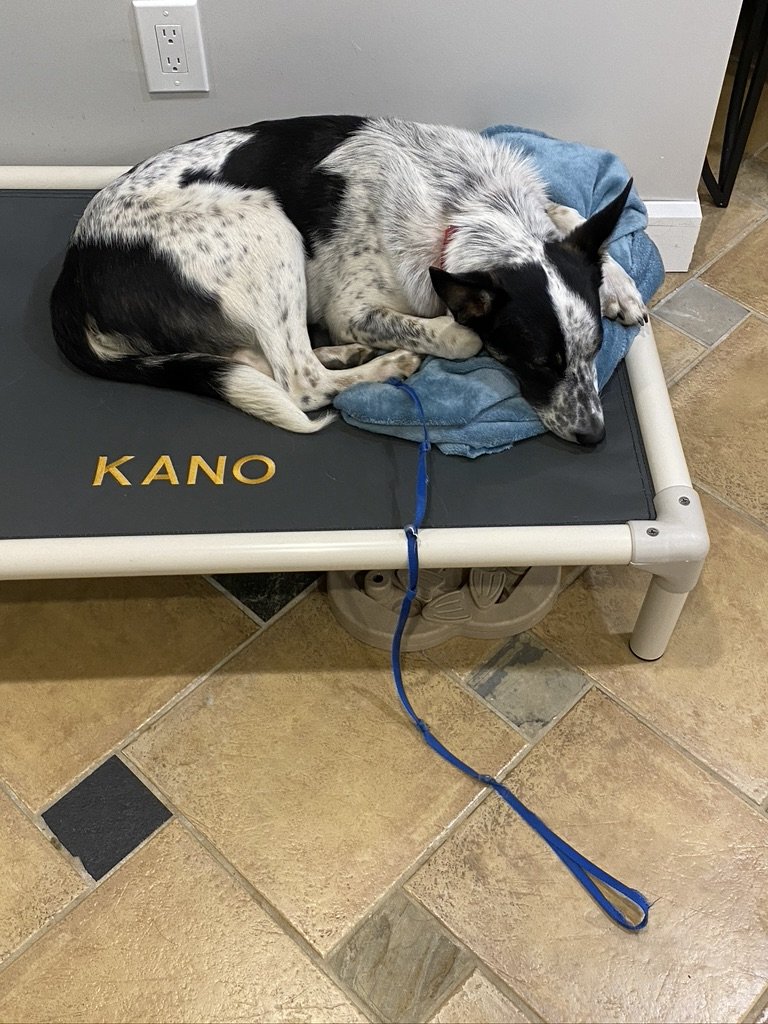(Photo: a brown and white puppy being held by a person wearing an Easter Bunny costume)
Let me tell you what I saw on Valentine’s Day in the back room of my vet’s office.
I watched a dog throw up an entire box of chocolates. He vomited non-stop as wrappers and chocolate gushed from his mouth. His body pulsed with effort. He was drooling, miserable, and wide-eyed.
Across from him, another dog was recovering from not one, but her second surgery in a week from ingesting the knot from her rope toy and clumps of her sibling’s fur.
Please pause to digest what I have just told you.
If you’re a part of the Beyond Dog Training family (working with us one-on-one, reading the blog, and watching our videos) you’ll know how much we value prevention. We don’t want your dog to have to spend an afternoon vomiting at the vet’s office and we certainly don’t want them to ever need surgery to remove something they’ve ingested (let alone two surgeries in one week.)
Prevent your dog from having to undergo surgery after ingesting something unsafe. Surgery is painful. (Photo: female doctor performing surgery)
Here’s how to prevent your dog from ingesting things that are unsafe for them to eat:
Supervision: Dogs require constant supervision while learning how to live in our confusing human world. Do not allow your puppy to race from room to room in your home unsupervised. Not only will this prevent them from eating something that could lead to a painful surgery, it will prevent window barking, unwanted chewing, cat-chasing, and kid-herding. If they are unsupervised it means you’re not there to teach them right from wrong, so how would they know that they aren’t supposed to toilet inside, chew couch cushions, or bark at the delivery person? They don’t know until you teach them.
Prevention: Do not leave food that is toxic to dogs on countertops, in purses, or inside backpacks. Store this food inside of cupboards that your dog can’t access.
It is your job as a pet parent to keep your dog safe. (Photo: black pug staring at a merengue on a table within his reach)
Crates: Dogs are den animals. Teach your dog to love her crate. If you tried when she was a pup and it didn’t go well, bring in an in-home trainer who can help you teach your pup to love the crate. When your dog learns to love napping in her crate, you can leave home knowing that she’s safe and can’t eat the chocolate that your roommate/partner/spouse/kids can’t seem to stop putting on the countertop.
There’s still time to teach your dog to love relaxing in her crate. (Photo: a dog relaxing in her crate)
Toy Check: Check all of your toys. If any of your toys look unsafe (could it be swallowed accidentally?) toss it in the garbage.
Leave It: Teach your dog the “leave it” command. Check out our ten part series on IG and FB @GoBeyondDogTraining and TikTok @BeyondDogTraining.
Drop It: This command is different from the “leave it” command. You can use “drop it” if your dog is playing with a toy that suddenly rips apart. Imagine all of the stuffing coming out of the toy and your dog gobbling it up along with the squeaker. “Drop it” would allow you to communicate to your dog to drop the fluff/squeaker, so that you can pick it all up and throw it in the trash.
Place Command: By giving your dog a job “lay calmly on your cot until I come and get you” while they are inside your home, you are keeping them safe from roaming around ingesting hair scrunchies, boxes of chocolate, shoes, and kid’s toys. The place command will also help you prevent window barking, jumping on your houseguests, separation anxiety, counter surfing, and chasing other pets and kids when you’re trying to cook dinner.
This is Kano’s first session learning the place command. See how quickly a dog can learn how to relax on a cot? Your dog can do it too. (Photo: Kano the cattle dog mix relaxing on his place cot)
One of the biggest mistakes people make is giving puppies and dogs too much freedom too fast. The result of allowing your dog to roam around your home unsupervised is unwanted behaviour and can sometimes lead to them ingesting things that can only be vomited out or surgically removed. Freedom in the home does not equal kindness. If your dog lived on the street in a feral pack, their leader would tell them when to hunt, when to eat, when and where to rest, what kind of play is acceptable and what is not, and when it’s time to migrate as a pack. Providing leadership keeps dogs safe.
There’s still plenty of time to teach your dog all of these life-saving skills before Easter. Schedule your free call now to prevent your dog from a painful surgery or from being very uncomfortable while vomiting on your vet’s floor.
You don’t want your dog to suffer. It’s time to teach them everything they need to know to keep them safe. Click the TAKE ACTION button and schedule your free call today.
Have a wonderful weekend, Dog Leaders.
Alyssa
Photos by: benjamin lehman @benjaminlehman (a brown and white puppy being held by a person wearing an Easter Bunny costume,)
Artur Tumasjan @arturtumasjan (female doctor performing surgery,) charlesdeluvio @charlesdeluvio (black pug staring at a merengue on a table within his reach,) Upsplash Images (a dog relaxing in her crate,) Alyssa Foulkes (Kano the cattle dog mix relaxing on his place cot.)





